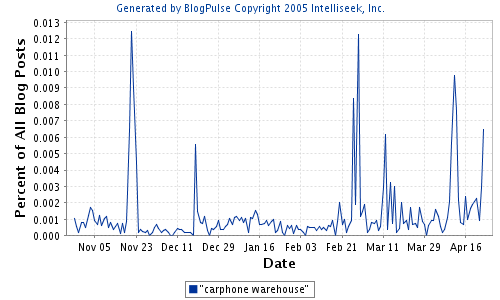 Would you trust your brand to your a divorce lawyer? If the answer is no, then why is it managed by the marketing department?
Would you trust your brand to your a divorce lawyer? If the answer is no, then why is it managed by the marketing department? Divorce lawyers have an interest in relationships. Specifically relationships with people seeking a divorce. A divorce is the irrevocable end of a relationship.
A Marketing department is interested in relationships. Specifically relationships with people in the value (by which I mean money) chain. A product or service, once purchased is the irrevocable endgame in the value chain.
But it is not the endgame for the organisation or the customer.
So Marketing invented 'customer relationship management'. This tends to be systematised aftersales marketing offering service, maintenance, spare parts, product peripherals, surveys, spam, pop-ups and call centre earache. The customer remains in the value chain until they fall out of the irrevocable endgame in the value chain because they stop buying. This is not customer relationship management, its selling.
It is the antithesis of the Craigslist, a company, reports the Sunday Times with a higher ROI, better earnings per share, and ratios that Glaxo, BP, General Motors and even Toyota can only dream about. Where a major corporation would like to get 7% net profit on turnover, Graigslist gets 300% net on turnover.
But then, major corporations have big marketing departments.
Craig has relationships.
His brand has an ethic and his model reaches out to deliver his brand values to the network, in the network, for the network and to recruit a network of relationships so that word of mouth delivers his stunning profitability and ROI. Other examples of organisations built on brand reputation include Skype, Google and Zopa etc.
I do not know why Stanford University has decided to promote "An Approach to the Measurement, Analysis, and Prediction of Brand Equity and Its Sources," which was published in the September 2005 Management Science journal but it did yesterday. In it V. "Seenu" Srinivasan, the Adams Distinguished Professor in Management at the Graduate School of Business with Korea University Business School Professor Chan Su Park, and Yonsei Business School Professor Dae Ryun Chang, have come up with a mathematical model and a market research method that allows managers to figure out how much more the company will earn if it invests in various kinds of branding activities.
Srinivasan and his colleagues developed an operational definition of exactly what "brand equity" is. "Having a better product or a larger sales force is not brand equity," he explains. "Brand equity is that incremental value that accrues to a product when it is branded."
This is common to other views such as those of Professor Leslie de Chernatony at University of Birmingham.
Simple brand awareness is one source of brand equity. Srinivasan says: "If you can get your name to pop up in people's minds when they think of the product category, you've won a big part of the battle."
Srinivasan and his colleagues also identified two other sources of brand equity: a consumer's perception that a brand is better than it really is ("attribute-based" equity), and nonattribute-based equity, for instance, a consumer's preference for a brand based on the cachet of owning it. "If you're successful in these three aspects, an added benefit is that stores will feel a customer pull to carry your product, and so your availability -- and hence sales -- will increase," Srinivasan says.
In doing calculations on cellular phone brands in Korea, Srinivasan found that simple awareness -- getting the brand's name to pop up in consumers' minds -- generates the largest return, followed by consumers' responding to the cachet of owning the brand (nonattribute-based equity). Attribute-based equity trails in third place. "This means that a brand's 'image' provides a stronger incentive for buying even than the perception that it is a better product," he explains. "But greater awareness of your brand is the major component driving brand equity."
From this we have thee elements that seem to be very important to brands. All three are value based but, for the most part, this value has little to do with money.
If we examine the Srinivasan hypothesis from a "Marketing" perspective there are three things to do: Shout, so that people remember the name of the brand. Tell customers they are getting a bargain and tell customers they are 'cool'.
Of course you need a big advertising and sales promotion budget to do this but as we all know... 'Advertising sells'.
What if we were to look at the Srinivasan hypothesis from a relationship (PR 3.0) perspective?
In the first instance, public relations has a significant advantage in gaining attention. It can work empathetically in many channels for communication without being intrusive and off-putting too gain attention when people are receptive and in the right frame of mind to be influenced. In a process of sharing values, the network is brought into play.
This process has the advantage that it keeps the 'brand' at top of mind because it is part of the consumer's value set and, additionally, relationship network and have a powerful emotional impact that is missing from advertising and typical sales promotion activities.
PR has used this approach with traditional print media for a long time. It works because of an emotional link between reader and publication and now we have the added channels for communication at our disposal.
In achieving "attribute-based" equity, and “nonattribute-based equity”, PR continues participation in the networked conversation. It never stops.
It continues to gain attention, as the network uses embed messages and makes the brand memorable.
The practice of public relations has to work to offer many cognitive devices using a range of social networks and channels for communication and content suited to a range of contexts.
The mono culture typical in many approaches to marketing communications (giving rise to expressions such as 'being on message') is inadequate and often counter productive.
People mistrust the robot response of 'on message' politicians.
People need context. Cognitive psychologists say that we carry a model or personal image of the world, relationships and other concepts around with us. We have several such models and apply the most relevant to the context of the moment (which I call a 'social frame'). For both understanding and acceptance PR creates and maintains its messages in contexts.
It is this context that provides the 'attribute based equity'. We know that the social frame of the individual creates personal contexts which include these extra-brand values.
The PR process offers tokens and values in an appropriate social frame which adds the campaign 'messages' to the understanding or personal model of the recipients in relevant context, the best channel and appropriate time . When this is done in such a way that both the organisation and the recipients gain an added value or understanding, the PR campaign will have been effective.
As the senses provide information we adjust these perceptions to arrive at cognitive consistency, (and resolve cognitive dissonance).
Meanwhile we now know that relying on the typical Marketing ploy of a few 'core messages' has dubious effect if it does not produce synaptic modulation. The secret of non-attribute-based equity is in the wider context of the network. Part of pride of ownership comes in that context when we can both be of a group and involved in social interaction – a condition that offers our brain huge rewards.
The significance of PR's multiple domains is that these skills can be applied in tandem to reach publics in a way no other management discipline can.
Public Relations is (can be) multi dimensional in a way the marketing cannot be. But it can create the awareness in context, the multiple touch and empathy that is needed to generate brand equity in a way that Marketing is incapable of approaching.
Picture: The Divorce Forum
 The range of communications channels vailable to practitioners is huge and today we get an incling of how they can be available for a whole family and for a wide range of devices in the home.
The range of communications channels vailable to practitioners is huge and today we get an incling of how they can be available for a whole family and for a wide range of devices in the home.











